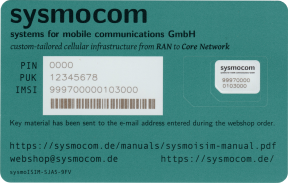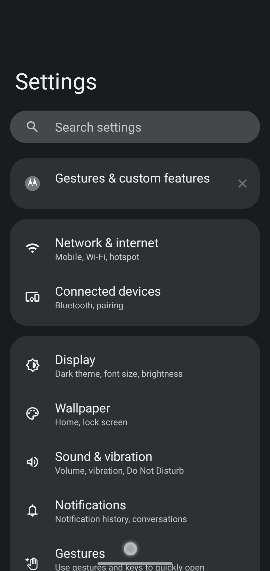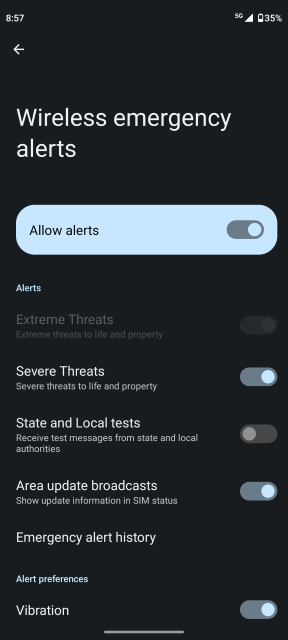⚠️ Warning: Setting up a GSM network involves using frequencies that are, in general, heavily regulated. In most jurisdictions, transmitting on these frequencies without proper authorization is against the law and subject to severe penalties.Familiarize yourself with your local telecommunications laws and be aware of the legal and operational risks involved, including the possibility of causing interference with emergency services and public communications. You might want to explore the possibility of using Faraday cages or direct connections from the base station (SDR) to the mobile station (such as a smartphone) to avoid unauthorized use of the spectrum.
The author and publisher of this guide explicitly reject any liability for illegal use or any adverse outcomes resulting from following this guide. The responsibility for any actions taken rests entirely with you.
This guide provides a straightforward method to set up a basic GSM network using a LimeSDR, software from the Osmocom project, and a Linux-based computer.
GSM is the second generation (2G) digital cellular network technology which mobile communications have once relied on. It has long been obsoleted due to its limitations and well-documented security vulnerabilities, being replaced by newer standards such as UMTS (3G), LTE (4G) and, more recently, 5G. Remarkably, despite its obsolescense, even the most current smartphones remain compatible with GSM!
The setup outlined in this guide supports voice calls and SMS between the GSM network's subscribers and is capable of providing emergency alerts over CB (Cell Broadcast). It also provides internet access, although the slow speeds of 2G technologies (GPRS and EDGE) render it impractical for using modern websites and apps, as even loading a simple page can take long minutes.
It should be possible to enable calls to and from other carriers by using the OsmoSIPConnector, PBX software, and a compatible SIP service provider. However, that is beyond the scope of this guide, as its focus is on creating a minimalist, self-contained network.
As for what is the practical purpose of setting up a GSM network, that is up to you. It could simply be for entertainment value, or it could serve as a means to explore the evolution of mobile communication protocols, including their security aspects. These DIY GSM networks are sometimes showcased at hacker events around the world as fun demonstrations, despite the questionable legality (see the warning at the beginning of this guide).
The Osmocom project does support the UMTS standard; however, its documentation indicates the need for a third-party hNodeB, a separate hardware component.
While the LimeSDR hardware is probably capable of handling the protocol, I haven't been able to find documentation on anyone successfully using it for that purpose. Online searches have led me to OpenBTS-UMTS, a now-discontinued project, making it challenging to find supporting resources. Given these difficulties, and since 2G met my experimental needs, I have decided not to pursue 3G.
For 4G and beyond, the srsRAN project is well-established, and provides examples such as a setup using a Raspberry Pi 4 and SDRs to create an eNodeB. While I haven't experimented with this yet, it is certainly on my future project list.
It's clear that 2G technology is outdated and insecure. No GSM network should be considered safe for transmitting sensitive information. Additionally, creating a GSM network like this could pose risks to both the host system and any other networks (e.g. Ethernet and Wi-Fi) connected to it.
The Osmocom project's components use a variety of TCP ports for different purposes. One key feature is the VTY (virtual terminal), which allows a user to connect, monitor, and tweak settings on a running component. In the setup we're discussing, these ports are configured to only accept connections from the local machine (localhost) and don't require any authentication. This means that anyone with access to the system could potentially log in, run commands, and change the settings of any active Osmocom component.
If this level of access doesn't suit your needs, you'll need to dive into the configuration files to tighten security, and consider strategies such as firewall rules that distinguish between users, utilizing network namespaces, among others.
Keep in mind that, as your GSM network offers internet access, there's a chance subscribers might misuse it. Forwarding packets could inadvertently expose other devices on your networks to unauthorized access from the GSM network users. As such, it's wise to implement appropriate firewall rules.
These setup instructions are based on a Debian 12 (“bookworm”) environment with a LimeSDR connected via USB. Should your setup differ, you may have to make adjustments to these steps.
In 2G networks, unlike on 3G/4G/5G, the network authenticates the subscribers, but the mobile devices are not required to authenticate the network itself. In effect, this means you can choose to have an “open” network that authenticates any device attempting to connect to it and, as such, does not require a custom SIM card to be used.
Your decision on whether to enforce authentication or not will significantly impact how users connect to your network and the technical steps required for your setup.
If you opt to enforce authentication, you will need programmable SIM cards and must program them with specific network parameters, including the PLMN1 lists and the authentication key (Ki)2. Furthermore, you'll need to add each subscriber to the network database managed by OsmoHLR.
If you decide for an “open” network, users can manually select your network by disabling automatic network selection in their phone's settings. Even without enforcing authentication, you can still use programmable SIM cards for automatic connection to your network (i.e. so automatic network selection doesn't need to be disabled), although those are not required for connection.
For programmable SIM cards, sysmocom is a renowned and reliable provider. Alternatively, marketplaces like Banggood and AliExpress offer inexpensive writeable SIM cards, though quality and features can vary.
One possible concern with SIM cards from these marketplaces is that they may sometimes require software provided by the vendors for writing parameters to them. Often, this software can be best described as opaque — its origins and functionalities are not transparent, raising legitimate concerns about security and integrity. There's a real risk of them containing malware.
If you find yourself needing to use vendor-provided software from these less reputable sources, you should take precautions such as running the software within an isolated virtual machine.
First up, add the Osmocom project repository to your system. On Debian, the simplest route to do so is by using extrepo. For other Linux flavors, refer to the Osmocom wiki.
apt install extrepo
extrepo enable osmocom-latest
apt updateNext, proceed to install the following packages.
apt install git \
telnet \
iptables \
limesuite \
osmo-hlr \
osmo-msc \
osmo-mgw \
osmo-stp \
osmo-bsc \
osmo-ggsn \
osmo-sgsn \
osmo-bts-trx \
osmo-trx-lms \
osmo-pcu \
osmo-cbc \
osmo-cbc-utilsIf you haven't done so yet, you might want to take this opportunity to check
that your LimeSDR is connected, updated and working properly, by running
LimeUtil --update and LimeQuickTest.
This repository contains the basic configuration files and auxiliary scripts needed for our setup. Clone it using Git.
git clone git@github.com:miraliumre/gsm.gitWithin the cloned repository, navigate to etc/osmocom for the relevant
Osmocom configuration files. Update these files based on your network
preferences.
First, in osmo-bsc.cfg, set the MCC3 and MNC4 for your network. As defaults, we have set 724 as the MCC because it is associated with Brazil, and 64 as the MNC to avoid conflicts with existing Brazilian carriers' MNCs.
network country code 724
mobile network code 64
In osmo-ggsn.cfg, you have the option to customize DNS and IP settings to avoid conflicts with your existing networks.
ip dns 0 8.8.8.8
ip dns 1 8.8.4.4
ip prefix dynamic 172.16.32.0/24
Next, in osmo-hlr.cfg, note the following directives:
-
ussd route prefix *#100# internal own-msisdnprovides a USSD5 service to display the user's MSISDN6 by dialing*#100#. -
ussd route prefix *#101# internal own-imsiprovides a USSD service for viewing the SIM card's IMSI7 by dialing*#101#. -
subscriber-create-on-demand 8 cs+psenables auto-registering for devices attaching to the network. It declares that each device should be assigned an 8-digit MSISDN, and be allowed to access both CS and PS services.
Edit osmo-msc.cfg to match the MCC and the MNC that you have previously
set on osmo-bsc.cfg. Here, you might also want to personalize the short name
and long name of your network. If you decide to require authentication, you
must change the authentication line to authentication required. Also notice
the encryption a5 0 line, which disables ciphering — this is required for
networks where authentication is set to optional.
network country code 724
mobile network code 64
short name Miralium
long name Miralium Research
authentication optional
encryption a5 0
In osmo-sgsn.cfg, if you decide to require authentication on your
network, you might want to change the auth-policy accept-all line to
auth-policy closed.
Finally, copy all the configuration files to the /etc/osmocom directory
on your system. A script for doing so is provided under src/update-cfg.sh for
convenience.
Use the src/osmo-all.sh convenience script to start all the required Osmocom
services (i.e. by running src/osmo-all.sh start). It is likely that the
services had already been started automatically when you installed them, so it
is recommended to completely stop them by running src/osmo-all.sh stop (and,
possibly, src/osmo-all.sh kill, if needed) before starting them again.
Once OsmoGGSN has started, it will create a TUN interface named apn0 from
which the GSM network subscribers will reach the internet. For it to work,
you'll be required to:
-
add an IP address to the newly created interface (in accordance with the settings in
osmo-ggsn.cfg);ip addr add 172.16.32.1/24 dev apn0
-
bring the interface up;
ip link set apn0 up -
enable IP forwarding;
sysctl -w net.ipv4.ip_forward=1
-
configure iptables as appropriate. At the very least, you will be required to set up NAT for both
apn0and the network interface that is connected to the internet (in this example,ens33), and to allow packet forwarding between those interfaces.iptables -t nat -A POSTROUTING -o ens33 -j MASQUERADE iptables -t nat -A POSTROUTING -o apn0 -j MASQUERADE iptables -A FORWARD -i apn0 -o ens33 -j ACCEPT iptables -A FORWARD -i ens33 -o apn0 -j ACCEPT
Note that none of these settings is persistent by default. If you want for
them to persist across reboots, you'll have to decide on which strategies to
use (e.g. editing /etc/sysctl.conf, using startup scripts, installing
iptables-persistent, among other possible options).
ℹ️ Heads up: manually setting iptables rules while UFW is installed and enable can cause conflicts. For this setup, it is recommended that you uninstall UFW and use iptables directly.
If your GSM network has been set up to require authentication, connecting to it is straightforward, assuming your SIM card has been programmed correctly. Simply insert the SIM card into the mobile device, and it should automatically find and connect to the network.
In the case you are not using custom SIM cards, the connection process involves a few more steps, and these steps can vary significantly depending on the mobile device's operating system. For Android devices, navigate to Settings › Network & internet › Mobile network, locate the option for Automatically select network and disable this toggle.
After disabling the automatic selection, your device will search for available networks and present them to you. Your GSM network may not appear on the list by the configured name, but rather, as a numerical representation composed of the MCC and the MNC you have configured (e.g. “72464”). Upon selecting it, your device should connect to your network.
You can manage subscribers via the OsmoHLR's VTY interface. By default, OsmoHLR
binds its VTY to TCP port 4258. To connect, you may use telnet, as follows.
telnet 127.0.0.1 4258Upon successful connection, you will be presented with the OsmoHLR command
prompt. To begin with, enter the enable mode.
OsmoHLR> enableYou may list all available commands, as well as get help for a specific
command's parameters, by pressing the ? key.
For networks that require authentication, it's necessary to add subscribers manually, specifying their IMSI and Ki values. To create a subscriber, refer to the following example, and replace the placeholder IMSI 724640000000000 with the actual IMSI of the SIM card you are registering.
OsmoHLR# subscriber imsi 724640000000000 create
% Created subscriber 724640000000000
ID: 1
IMSI: 724640000000000
MSISDN: noneNow, assign a MSISDN to your subscriber. In this case, we'll be using 12345678. Remember, this is a placeholder and should be replaced with the actual phone number you wish to assign.
OsmoHLR# subscriber imsi 724640000000000 update msisdn 12345678
% Updated subscriber IMSI='724640000000000' to MSISDN='12345678'Next, specify the authentication parameters. This example uses comp128v1 as
the AUC algorithm, but depending on your SIM card settings, comp128v3 may be
required. The Ki (authentication key) provided here is a placeholder and must
be replaced with the actual Ki of your SIM card.
OsmoHLR# subscriber imsi 724640000000000 update aud2g comp128v1 ki 00000000000000000000000000000000Specify the network access mode (e.g., cs+ps for both circuit-switched and packet-switched access).
OsmoHLR# subscriber imsi 724640000000000 update network-access-mode cs+psTo view the updated information for a subscriber, use the show command.
OsmoHLR# subscriber imsi 724640000000000 show
ID: 1
IMSI: 724640000000000
MSISDN: 12345678
2G auth: COMP128v1
KI=00000000000000000000000000000000Once a device is connected to the GSM network, calls and SMS should just
work. To figure out the phone numbers to call and/or send messages to, look up
each subscriber's MSISDN. You can either do this directly from the host system
(e.g. by querying the OsmoHLR VTY) or by using the USSD service on a mobile
phone to find out its assigned number (dial *#100#).
Unlike with calls and SMS, internet access through your GSM network might require some additional configuration on the mobile device itself.
First off, if your GSM network is set up without authentication, or if your SIM's PLMN settings are incorrect, the mobile device might think it's roaming. This often means it'll automatically turn off data to avoid charges. To get around this, you may either tweak your SIM's configuration, which is only possible if you are using your own programmable SIM cards, or enable data roaming.
To determine if your Android mobile phone is in roaming, simply look at the status bar at the top of your phone's screen. If you see an "R" next to your signal strength bars, this indicates that the phone is currently in roaming mode.
![]()
Roaming symbol shown on an Android smartphone by The RedBurn, Mark Groves on
Wikimedia Commons
Next up, your device will require APN (Access Point Name) settings to successfully access the internet. Usually, carriers push these settings to subscribers through OTA updates, but here, we'll just set it up manually.
For Android users, head to Settings › Network & internet › Mobile network › Access Point Names. Here, add a new APN with any name and APN value you prefer. Just ensure the MCC and MNC matches your setup. After that, save your new APN and select it to get connected.
I have seen older, non-Android phones with different setup requirements. In those cases, you might need to browse through the menus and figure out which configurations may be missing.
ℹ️ Heads up: in my experience, I have found it extremely difficult to have modern Android smartphones successfully use the GSM network for internet access at all. I suspect the system and its apps might be sending too much data at once, possibly overloading the network, and often assuming that connection isn't available when it actually is, just extremely slow. For that purpose, using the older “dumb phones” appears to work best.
You can broadcast emergency alerts on the GSM network using the REST API
provided by OsmoCBC. The osmo-cbc-utils package provides a command line tool
named cbc-apitool.py to interact with said API.
For example, the following command sends an Extreme Alert message to the network.
cbc-apitool.py create-cbs \
--msg-id 4371 \
--payload-data-utf8 "Something has happened."From my experience, transmitting these alerts and ensuring that they are successfully received by the devices on the network can be somewhat tricky. As such, it's advisable to familiarize yourself with the specifics of CB technology.
Some issues you might run into:
-
Devices might have emergency alert messages disabled, or in rare cases, may not support them at all.
-
Messages that share the same ID and update number are treated as identical, regardless of any differences in their content. Therefore, if you create message with a specific ID, delete it, and then try to issue a new message without altering the update number, devices that received the initial message might not display the subsequent one.
-
Content length and character encoding issues may cause the alerts not to be displayed by the devices.
ℹ️ Heads up: on Android, emergency alert settings are usually under Settings › Notifications › Wireless emergency alerts. On iOS, look for Settings › Notifications › Government Alerts.
Cellular technology and its related components, including the Osmocom project, are fascinatingly complex. Although this guide gives you a straightforward path to setting up a GSM network quickly, you might want to dive in deeper to further your understanding.
The Osmocom project offers their own configuration guide for a basic and minimal setup of a 2G/3G network. It goes into more detail about each component, illustrating the relationship and communication flow between them.
Additionally, each component within the Osmocom project has its own user manual and VTY reference, all accessible on the project's website.
This repository is open for contributions! If you've spotted a mistake, have suggestions for improvements, or want to expand on the content, please feel free to open an issue or submit a pull request.
This guide builds upon the work of Lucas Teske, who first wrote about this topic back in 2019, and later talked about it at the RF Village at the H2HC in 2022.
A huge shoutout is also due to the entire open source community that has created and supports projects such as the LimeSDR and Osmocom. It is because of these efforts that individuals and small business can now research complex radio communication protocols without shelling out massive amounts of cash for high-end equipment typically reserved for the giants in the telecom industry.
Footnotes
-
PLMN (Preferred List of Mobile Networks) refers to a list stored on a SIM card containing the mobile networks that the subscriber should connect to. This list is used by the mobile phone to automatically select one of the networks when they are available. ↩
-
Ki is a 128-bit value used in the authentication and ciphering process between the mobile device and the GSM network. It is stored both in the subscriber's SIM card and the network's database, and is used to authenticate the authorized users to the network. ↩
-
MCC (Mobile Country Code) is a three-digit code assigned to each country, used to identify the country in which a mobile subscriber belongs. ↩
-
MNC (Mobile Network Code) is a two or three-digit code used in combination with the MCC to identify a mobile phone operator within a country. Each operator has unique MNCs (often more than one), which, when paired with the MCC, forms an unique operator identification worldwide. ↩
-
USSD (Unstructured Supplementary Service Data) is a messaging technology allowing a session-based, two-way exchange of a sequence of data. One of its uses is providing users with access to network services by dialing short codes, typically starting with * and ending with #, without the need for an internet connection. ↩
-
MSISDN (Mobile Station International Subscriber Directory Number) is a number uniquely identifying a subscription in the GSM network. Simply put, it is the phone number. It is stored on the network's database, where it can be looked up in relation to the IMSI. ↩
-
IMSI (International Mobile Subscriber Identity) is a unique identifier for each user of the network. It is stored on the SIM card, composed of up to 15 digits, and structured to include the MCC, the MNC, and a unique subscriber number. ↩



